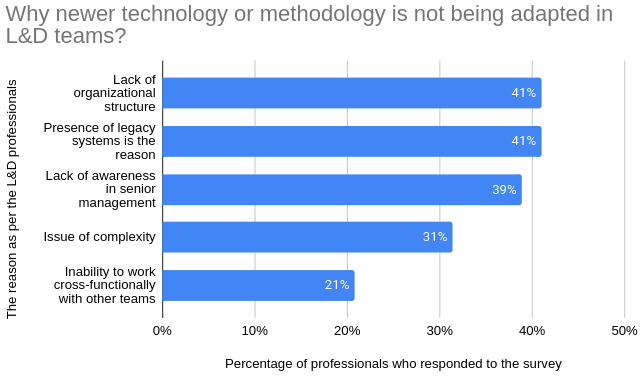Using Agile methodology for eLearning course development
05 Oct

Table of Contents
ToggleeLearning course development processes have come a long way. There are a lot of methodologies in the realm of instructional design which can be used to create an eLearning course. With time, the eLearning course development process has become more and more efficient, faster and has successfully generated courses with higher business value.
However, due to the COVID-19 pandemic, the rate at which eLearning development teams aspired to innovate was reduced. Over 1100 L&D professionals were surveyed by the Learning Guild and the bar graph below has a lot of interesting elements to share.

More and more eLearning professionals are inclining towards making their process and their team agile. Here in this article, we have summarized quite a few elements which could help you in understanding agile in terms of eLearning.
Existing eLearning development processes vs Agile
There are a lot of eLearning course development processes that are in practice at the moment. All of them have their own pros and cons. However, slowly but steadily, eLearning professionals have been iterating their processes to make them more agile. Below we have summarized some workflows which would assist you in measuring these flows and integrate agile in eLearning.
ADDIE vs Agile
ADDIE is one of the oldest workflows around and even though it has some issues in regard to collaboration and getting continuous feedback, it works. It is easy to set it up and easy to implement.
Pros:
- Very common and old, so a lot of documentation is available.
- Flexible in nature and can be utilized to build almost any type of course.
- Reduced base cost so it basically works in any kind of cost cap.
- Easy to modify the process based on needs.
Cons:
- Linear process due to which information flows unidirectionally.
- Phases come one after another, not parallelly.
- To make modifications, the developers need to go back to a phase.
- Could prove costly if the idea outline phase is not done correctly.
Conclusion: It is linear and it allows the flow of information in one direction. Moreover, things like design and development don’t go hand in hand and instead go step-by-step. Although there are different modifications of ADDIE to make it appear agile, it is hard to modify the core idea of ADDIE itself. Employing ADDIE won’t help you achieve agile in eLearning.
Calculate Your eLearning Content Development Cost
Ever wondered how much money and time you spend developing your learning content?
Download the CalculatorDick and Carey’s method vs Agile
Inspired by Gagne’s approach, Dick and Carey’s method, AKA Systems Approach Model is generally used to build courses for schools.
Pros:
- Very systematic which makes it easier to understand its core principles.
- Robust architecture, due to which this approach was used in military training.
- Built-in intermittent review cycles.
Cons:
- Still a predefined process that stops it from being agile.
- A lot of steps and documentation, and it consumes some resources to be understood and applied.
- None of the steps are skippable.
Conclusion: From the top, it is still a linear process even though it does take in a lot of inputs from the learners. It is robust and systematic but it is that to a level that none of the intermittent steps are skippable. There is a lot of importance associated with each step. Dick and Carey’s method will give good results although it doesn’t really capture the principles of agile in eLearning.
Turn on audio👆
SAM vs Agile
The Successive Approximation Model has been adopted by ASTD(American Society for Training and Development) and has proven itself in many ways, even though it is relatively new.
Pros:
- Iterative and responsive to changes.
- Consistent and periodic review cycles.
- Good resource allocation and the resulting eLearning course have a better product-market fit.
Cons:
- The design phase and development phase are separate, even though they are iterative.
Conclusion: There are still some changes that could be incorporated to make SAM completely agile. One of those things is integrating the design and development phase into one complete iteration. However, it is a great start for any eLearning course development team to implement agile in eLearning.
Effects of Agile in eLearning
The agile methodology enables the developers to create courses that have higher business value as it helps the learners achieve their desired outcomes. It also assists in reducing costs and delivering qualitative eLearning courses faster.
Improved learner engagement
Since the eLearning course has been developed in terms of the learners’ needs and clients’ specific issues, it has a higher retention rate. The process of receiving continuous reviews and feedback from the learners throughout the development process helps the developers create a more streamlined course.
For example, if an L&D team designs a course by taking inputs from the learners periodically, the course will have a better success rate. It will fill the output void and will improve overall performance.
Smoother incorporation of changes
Developing an eLearning course takes weeks or sometimes even months. At the same time, there can be shifts in the overall requirement as was planned at the time of the planning phase. By incorporating Agile in eLearning, these changes can be predicted way earlier. As a result, they will not be springing up as surprises in the later stage.
For example, if 20% of an eLearning course is already created and new reviews suggest that the present model of the course will not yield good results, pivoting is needed. Agile’s principles suggest the same.
Higher business value
An eLearning course is usually developed keeping in mind the performance void that it is aimed at filling. With the adoption of Agile in eLearning, development teams can continuously integrate changes based on the learner’s demand and still stick to the main vision of the project.
For example, designing a course based on what developers think their client might need is not ideal. The course should be designed on the basis of what the clients’ problems are and understanding the end-users’ pain points.
Predictability
The first principle of agile, “individuals and interactions over processes and tools” encourage developers, learners, clients, and stakeholders to communicate more and productively. It assists everyone involved to predict any discrepancies in the eLearning course development process and eliminate them. That is why Agile in eLearning development is being rapidly adopted.
For example, if you have all the information about an eLearning course before designing it, you can predict a lot of things about it’s impact. Information like intent of the course, duration, viability, target audience and deadlines are important to have before you proceed to build a course.
Improved Quality
Agile in eLearning development helps the professionals build the course in small iterations. As a result user testing becomes easier and faster which develops the overall quality of the course.
For instance, an eLearning course that is developed through multiple iterations in bite-sized chunks through constant review processes will be better. Agile’s principles take the guesswork out in the entire procedure.
Kevin Doherty
Marketing Communications Manager for Vyond.
Kevin is an experienced agilist and here, he shares the history, values and principles of agile and how process shifts will help you take your content to the next level.

Iterative and actionable steps in Agile’s implementations
Understanding the Agile Manifesto
To be able to use agile in the eLearning development process, it is important to take a closer and harder look into the principles of Agile. Below are the four core principles of agile and certain examples of how an eLearning development team can implement those into their workflow.
Individuals and interactions over processes and tools
How to implement this principle: Give primary importance to the individuals involved. In the initial stage focus on what the client’s problem statement is and how the SMEs address the issue. As the eLearning course is developed, take inputs from clients, learners, and SMEs(if needed). To capture the essence of this principle of agile in eLearning development, it is crucial to choose the workflow and the tools required to build the course after designing the outline of the course correctly and completely.
Potential challenges: Although this process seems quite simple and straightforward, it is challenging to adopt if the organization is big. The reason being there are existing processes and tools which have been used for a long and it is difficult to get the whole team on board with this strategy even though it is positive. Simultaneously, if there is management involved making changes to the workflow would be even more difficult.
Working software over comprehensive documentation
How to implement this principle: This principle of agile in eLearning development helps the eLearning course development teams target the problem that is faced by their client and solve it. In many cases, it is increased output or performance which is desired by the client. However, it is sometimes misconstrued as a lack of knowledge and the course created is extremely vast and contains a lot of information. Not only it will affect employee motivation badly, but also it doesn’t guarantee a better result.
Potential challenges: The issue lies with effective communication. In one case, the client describes what they think might work and when the course is built, it doesn’t produce the desired effect. In some other cases, the course is built with the interpretation of the SMEs’ understanding of the problem statement which results in an eLearning course that is information-rich and vast. To tackle this issue, the developers, clients, SMEs, stakeholders need to understand the void that they are aiming to fill and test the course in regular intervals during the development phase with the learners.
Customer collaboration over contract negotiation
How to implement this principle: Shift your focus on the learners’ needs and providing them with an eLearning course that will help them perform better. In today’s era of terms and conditions, it is easy to get caught up with the terms of engagement. However, implementing this principle of agile in eLearning development lets the developers collaborate with their clients instead of just having a business transaction.
Potential challenges: Collaborating with your client to create an eLearning course that is best suited to their needs is a taxing task. It involves a lot of discussion in the presence of the SMEs and sometimes it is a lengthy process.
Responding to change over following a plan
How to implement this principle: Plans are important and without them, an eLearning course will take forever to be built. However, it is equally important to create a plan which is adaptive and responsive to external feedback.
Potential challenges: Implementation of this final principle of agile in eLearning development is very common. However, this principle will be properly adapted if and only if the whole team is agile. If the eLearning course development team functions in a traditional, non-agile way, it will be a lengthier and slower process than ideal.
[FREE eBOOK]Understanding agile for eLearning
Grab your free copy to learn how agile can be implemented easily in the eLearning development process
DownloadWhat eLearning course development teams can do?
1. Plan the course-building strategy in an agile way. Take inputs from clients, learners, SMEs, and stakeholders while building the outline of the course.
2. Prototyping the course. Create an MVP that will help the learners get an idea of what they would be going through. An eLearning course prototype will serve as something tangible and getting visual feedback will be even easier.
3. Reviewing and getting feedback. Learners’ feedback matters the most as they are the ones who would be the consumers of the content. Receiving opinions from the learners while testing an iteration of the eLearning course in a sprint will help the developers create a better course. Moreover, it will have a higher business value that will help them fill the void in performance.
4. Iterating the eLearning course development plan. After receiving the reviews, prioritize each of them and turn them into actionable tasks if necessary. Having an efficient system for backlog prioritization helps.
Related Post
Recent Posts
- MEP Document Management: How to Streamline Reviews & Avoid Rework October 3, 2025
- What Is Online Proofing Software? And Why Content Review Breaks Without It July 11, 2025
- How Laerdal Medical Cut eLearning Review Time by 50% with zipBoard’s Visual Review Tool July 9, 2025
- Why Your Team Needs a Content Feedback System (Not Just Comments in Docs) May 28, 2025
- Content Approvals Are Slowing You Down — Here’s the Fix May 26, 2025
©️ Copyright 2023 zipBoard Tech. All rights reserved.


